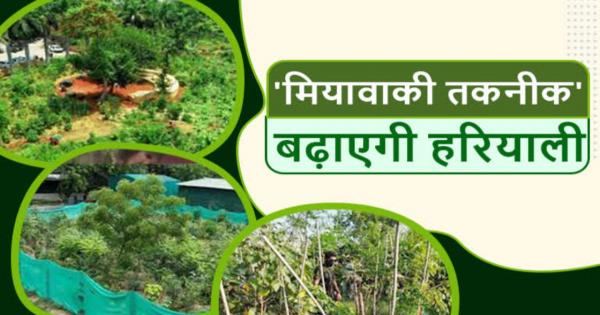Amrit Vichar, Prayagraj: To ensure that the devotees coming to Mahakumbh get pure air and environment, the Yogi government has developed dense forests at many places in Prayagraj. Prayagraj Municipal Corporation has developed several oxygen banks using Japanese technology Miyawaki in 2 years, which have now taken the form of dense forests, which is helping a lot in environmental protection. Along with the spread of greenery from these plants, the air quality has also improved.
Miyawaki technique is better
Dr. NB Singh, former professor of Botany Department of Allahabad Central University and famous as Hariyali Guru, said that due to urbanization, both pollution and temperature have increased. Miyawaki technique is best in this situation. There is a lot of difference between day and night temperatures in summer. This forest will reduce that gap. Along with this, biodiversity, fertility of land and animals and birds will increase. Due to this increased forest, the temperature decreases by 4-7 degrees.
1.2 lakh saplings planted in Naini industrial area
Prayagraj Municipal Corporation has planted saplings at more than 10 places in the city using this technique. Saplings have been planted in 55,800 square meters in the last 2 years. 1.2 lakh saplings have been planted in Naini industrial area alone. Municipal Corporation’s Assistant Engineer Girish Singh said that this technology develops dense forests rapidly. We had planted saplings in Naini industrial area about a year ago, which have now grown to a height of 10 to 12 feet. In Japanese technique Miyawaki we plant 3 to 4 plants per square meter. By removing industrial waste from here, the soil was made suitable for plants through sawdust and organic manure. Devotees coming to Mahakumbh can also see it. Junior Engineer RK Mishra says that the temperature has also reduced due to this forest. Wherever space is less, we can develop such forests with this technology.
Dense forest with biodiversity developed by removing garbage
Actually, Miyawaki project in Prayagraj was started about 4 years ago in 2020-21. This beginning made on a small scale was given a big shape in the year 2023-24, when 1 lakh 19 thousand 700 saplings of 63 species were planted in an area of 34200 square meters in Nevada Samogar of Naini Industrial Area. This area was then covered with industrial waste. The waste generated from local industries was dumped there. Due to this there was dirt and smell everywhere. Due to this, the people of nearby villages as well as the people passing by were troubled. Keeping this in view, saplings were planted here under Miyawaki Project.
27 thousand saplings of 27 species planted in Baswar
Along with this, saplings were also planted in Baswar, the city’s largest garbage dumping yard. Here, after cleaning the garbage, 27 thousand plants of 27 species have been planted in 9 thousand square meters. Now these plants have taken the shape of a very dense forest. According to officials, after this, while the local people got relief from dirt and bad smell, the environment has become clean and the temperature has also dropped. Apart from this, Miyawaki forest has been developed at about 13 places in the city. Through this, dense forests can be developed even on very limited space and barren land.
plantation of special species
Along with maintaining biodiversity, plant species of public utility have been included in this project. These include Mango, Mahua, Neem, Peepal, Tamarind, Arjun, Teak to Tulsi, Amla, Plum, Kadamba, Hibiscus, Kanji, Amaltas, Guava, Amla, Gold Mohar, Jungle Jalebi, Bakken, Shisham, Waterbrush, Kaner (red and Yellow) Ticoma, Kachnar, Voganwellia, Mahogany, Bamboo, Cirrus, Khas, Drumstick, Chandni, Contains green semolina, lemon and brahmi.
What is Miyawaki technology?
It was discovered by the famous Japanese botanist Akira Miyawaki in the 1970s. This is also known as potted plant method. In this method, plants are planted at a short distance from each other, so that they can grow quickly. In this, saplings are planted in small places, which grow 10 times faster. This method realized the concept of forests in cities.
Special features of Miyawaki method
This technique involves planting dense, mixed native species of plants to mimic a natural forest. The quality of soil improves. Increases the growth of forests rapidly. Trees planted with this technique grow faster and absorb more carbon. Miyawaki’s forests have greater biodiversity than other forests.
Benefits of Miyawaki Forest
While this project has resulted in disposal of industrial waste, it has also provided relief from dust, dirt and bad smell. Apart from this, the project is also helping in reducing the air pollution of the city. Help in reducing air pollution. Help in reducing water pollution. Help in preventing soil erosion. Help promote biodiversity. Municipal Commissioner Chandra Mohan Garg said that dense forests are being developed using Miyawaki technology at many places in the city. We have removed garbage in Baswar and planted 27 thousand saplings there also using this technique. Maximum 1.2 lakh saplings have been planted in Naini industrial area. This project is not only helping in disposal of industrial waste but also getting rid of dust, dirt and smell. Apart from this, it is also helping in reducing the air pollution of the city. Miyawaki Forest has many benefits. This is reducing air and water pollution as well as preventing soil erosion and promoting biodiversity.
Also read-CM Yogi said – Sanatan’s tradition is higher than the sky, it cannot be compared










